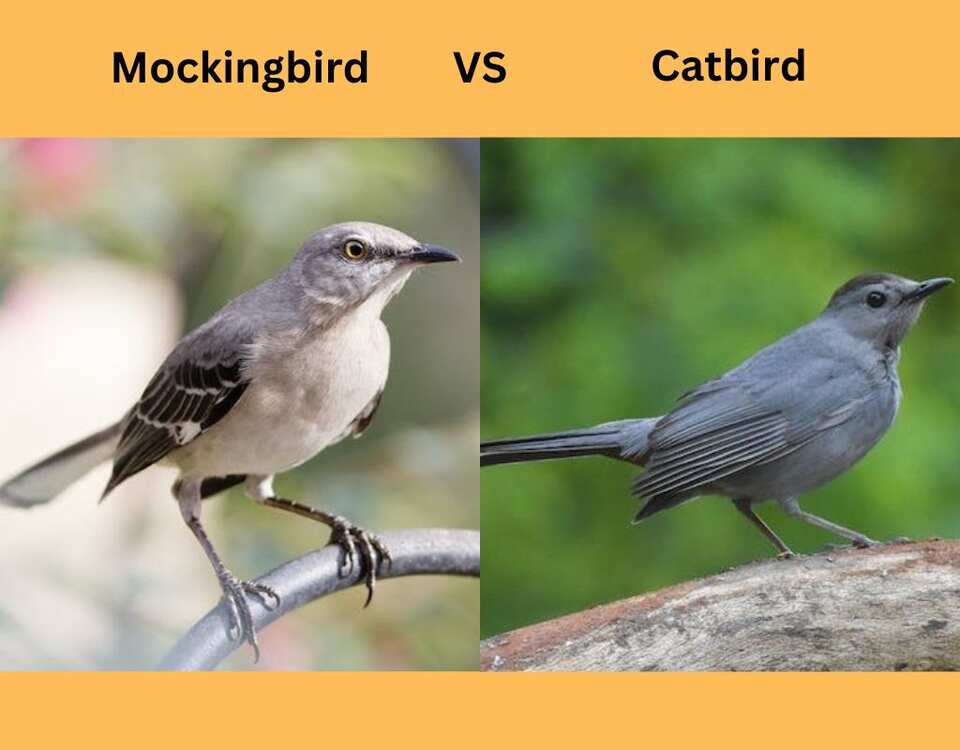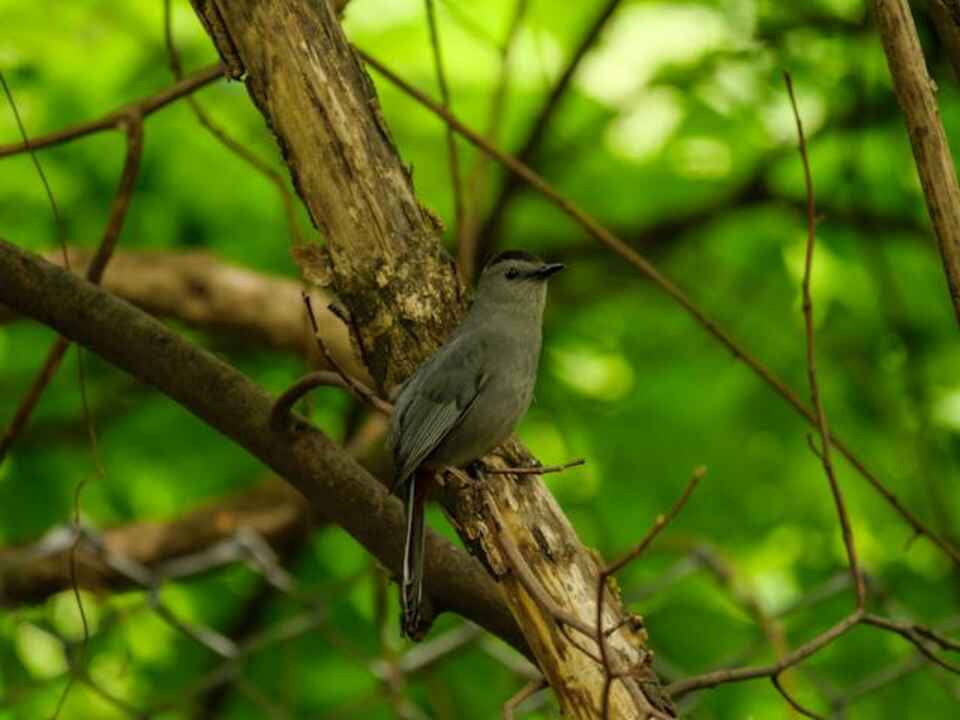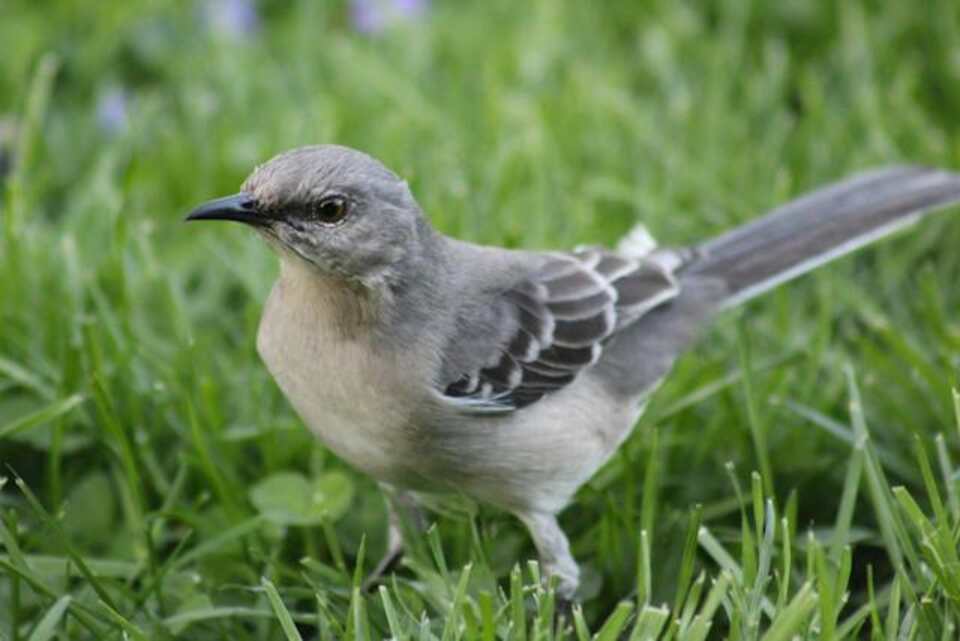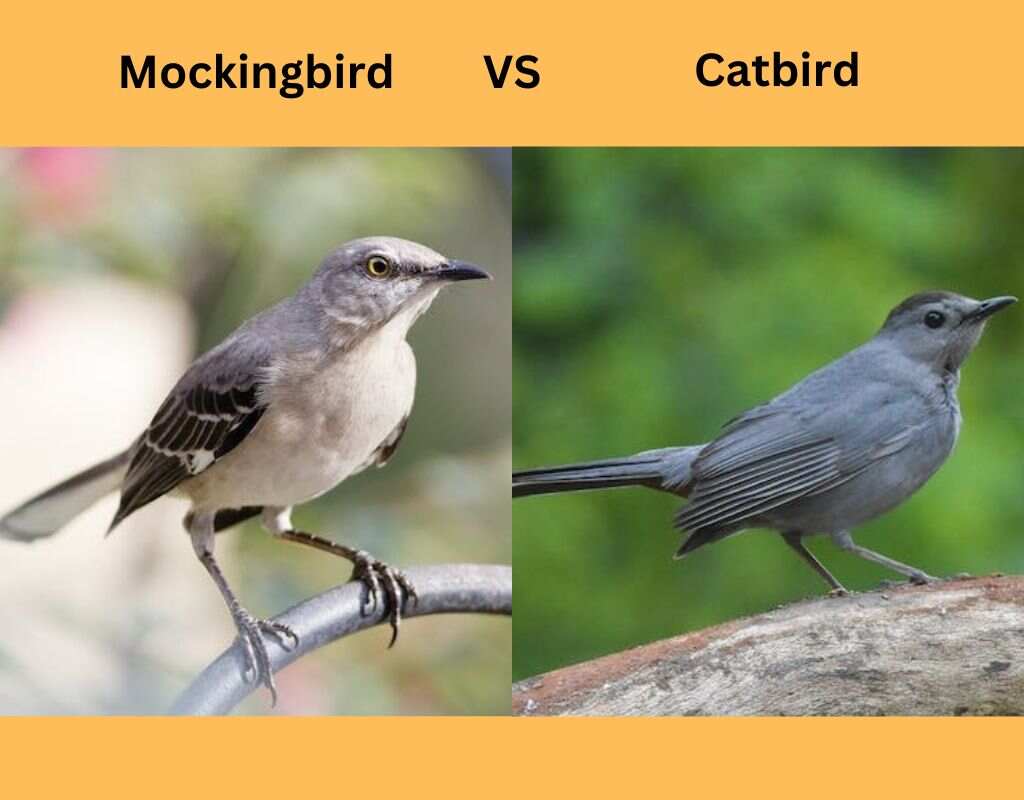Welcome to the showdown between two fascinating birds: the Catbird and the Mockingbird. As someone who loves watching birds, I’ve done my homework to bring you the inside scoop on what makes these two feathered friends stand out. We’ll be comparing their behaviors, quirks, and distinctive traits. Get ready for the ultimate face-off in this Catbird vs. Mockingbird guide!
Table of Contents
- 1 Key Takeaways
- 2 Catbird vs Mockingbird Habitat and Range
- 3 Catbird vs Mockingbird Appearance
- 4 Catbird vs Mockingbird Behavior and Vocalizations
- 5 Catbird vs Mockingbird Feeding Habits and Diet
- 6 Catbird vs Mockingbird Breeding and Nesting Habits
- 7 Catbird vs Mockingbird Migration Patterns
- 8 Catbird vs Mockingbird Similarities and Differences
- 9 Conclusion
- 10 FAQs
- 10.1 What are the similarities and differences between Catbirds and Mockingbirds?
- 10.2 Where can Catbirds and Mockingbirds be found?
- 10.3 What are the feeding habits of Catbirds and Mockingbirds?
- 10.4 How do Catbirds and Mockingbirds behave?
- 10.5 What are the breeding and nesting habits of Catbirds and Mockingbirds?
- 10.6 Do Catbirds and Mockingbirds migrate?
- 10.7 Where can I learn more about Catbirds and Mockingbirds?
- 11 Author
Key Takeaways
- Learn about the differences and similarities between the Catbird and the Mockingbird
- Explore their habitat and range preferences
- Examine their physical characteristics and appearances
- Discover their feeding habits and diets
- Understand their breeding and nesting behaviors

Catbird vs Mockingbird Habitat and Range
As previously mentioned, both the Gray Catbird and the Northern Mockingbird are native to North America. However, their habitat preferences and ranges differ slightly. The Catbird can be found in wooded areas with dense shrubbery and thickets, while the Mockingbird is more versatile in its choice of habitats. It can be found in open fields, suburban areas, parks, and even deserts.
Within their respective habitats, both birds carve out territories for themselves. The Catbird is known to defend its territory from other birds, while the Mockingbird may be more tolerant of other bird species in its vicinity.
Catbird Habitat
It’s worth noting that Catbirds may also be found in gardens and backyards with shrubs and trees. They may take advantage of bird feeders and even build their nests in these suburban areas.
Mockingbird Habitat
Mockingbirds are attracted to open areas with low shrubs and small trees, and they will often use these structures to construct their nests. They are also drawn to gardens with fruit trees and berry bushes, as these provide food sources for them.
Both the Catbird and the Mockingbird are territorial birds, establishing their presence in their respective habitats. Understanding their preferred habitats and ranges can help birdwatchers spot and identify them more easily.
Catbird vs Mockingbird Appearance
One of the most noticeable differences between the Catbird and the Mockingbird is their size. The Catbird is smaller compared to the Mockingbird. An adult Catbird typically measures around 9 inches in length, while the Mockingbird measures up to 10 inches long.
Both species have grayish-brown plumage, but the Catbird has a black cap on its head and a long slender bill, while the Mockingbird has a white belly and prominent white wing patches. Additionally, the Catbird’s eyes are a bright red color, while the Mockingbird’s eyes are dark brown.
The Catbird’s plumage may also appear slightly more ruffled than the sleek feathers of the Mockingbird. These physical characteristics make it easy to distinguish between the two species.
| Catbird | Mockingbird | |
|---|---|---|
| Color | Grayish-brown plumage with a black cap on the head | Grayish-brown plumage with a white belly and prominent white wing patches |
| Size | Measures around 9 inches in length | Measures up to 10 inches long |
| Bill | Long and slender | Straight and slightly curved |
The physical characteristics of the Catbird and the Mockingbird are well-suited to their respective environments and allow for easy identification.
Photo of a Gray Catbird below:

The Catbird and the Mockingbird may both be songbirds, they have distinct physical characteristics.
The differences in their appearances are not just superficial but have implications for their behavior, ecology, and evolutionary adaptations. Understanding these differences provides insights into the ecology of these remarkable birds.
Catbird vs Mockingbird Behavior and Vocalizations
As songbirds, the behaviors and vocalizations of the Catbird and the Mockingbird are of particular interest to birdwatchers.
“The Catbirds frequent bushy places and orchards,” wrote John James Audubon in his Ornithological Biography. “They are also fond of gardens in the vicinity of houses, where they find a great abundance of insects.”
Vocalizations: Both the Catbird and the Mockingbird are known for their unique songs and calls. The Catbird has a melodious and distinctive meowing call, which is often repeated several times in succession.
The Mockingbird, on the other hand, is renowned for its ability to mimic the songs of other birds, sometimes even incorporating the sounds of car alarms, sirens, and other environmental noises in its repertoire.
In fact, the Mockingbird’s ability to mimic sounds has earned it the title of “the Northern Mockingbird,” or simply “the Mockingbird.”
Songs: The songs of the Catbird and the Mockingbird are quite different. The Catbird’s song is a series of musical notes, which can be described as a cross between a meow and a whistle. The Mockingbird’s song is more complex, with a variety of different notes and sounds, often including the songs of other birds. The Mockingbird’s repertoire can include over 100 different songs and calls.
| Catbird | Mockingbird | |
|---|---|---|
| Behavior | Secretive and skulking, avoids confrontation | Highly territorial and aggressive towards other birds, often confronts birds several times its size |
| Vocalizations | Melodious meowing call, often repeated several times in succession | Renowned for its ability to mimic the songs of other birds and incorporate environmental sounds in its repertoire |
| Songs | Series of musical notes, cross between a meow and a whistle | Complex with a variety of different notes and sounds, often including the songs of other birds |
Overall, the Catbird and the Mockingbird exhibit different behaviors and vocalizations, but both are fascinating songbirds that add beauty and complexity to the avian world.
Catbird vs Mockingbird Feeding Habits and Diet
As omnivores, both the Catbird and the Mockingbird have diverse diets that are influenced by their habitats, feeding habits, and seasonal availability of food. However, they do have some differences in their dietary preferences.
Despite their differences in dietary preferences, both species play important roles in their respective habitats as seed dispersers and insect controllers. Their varied diets contribute to their overall health and survival in the wild.
Catbird vs Mockingbird Breeding and Nesting Habits
The Catbird and the Mockingbird exhibit unique breeding and nesting habits that contribute to their survival and family lives.
The Catbird builds cup-shaped nests in dense vegetation, such as shrubs and bushes, which provides cover and protection for their offspring. They are known for their territorial behavior, defending their nesting territories fiercely against intruders. During the breeding season, male Catbirds perform a display flight, flying upward then diving rapidly, to attract potential mates.
Mockingbirds, on the other hand, construct nests in trees and shrubs, preferring open areas with scattered trees. They may also nest in dense vegetation, such as cacti. Like Catbirds, they are protective of their nesting territories and will fight off intruders. Mockingbirds are socially monogamous, and both parents take part in incubating and raising the chicks.
While both species may have similar nesting habits, the location and structure of their nests differ. Understanding their nesting behaviors can help you identify their nests and offspring in the wild.
“The Catbird builds cup-shaped nests in dense vegetation, while Mockingbirds construct nests in trees and shrubs. Understanding their breeding and nesting behaviors will give you insights into their family lives.”
Catbird vs Mockingbird Migration Patterns
Migration is a natural instinct in birds that allows them to seek out favorable conditions for survival. The Catbird and the Mockingbird are no exception, exhibiting different migration patterns depending on their habitat and range.
During the breeding season, which typically occurs from April to August, both the Catbird and the Mockingbird can be found in North America. However, when it comes to the non-breeding season, their migration patterns differ slightly.
On the other hand, the Mockingbird may migrate shorter distances or remain in their breeding territories year-round, depending on the availability of food and suitable habitat. This adaptability allows them to survive in a variety of environments, including urban areas and suburban neighborhoods.
Both the Catbird and the Mockingbird exhibit territorial behavior, which may impact their migration patterns. They are known to defend their feeding and nesting territories fiercely, which may limit their range during the non-breeding season.
Photo of a Northern Mockingbird below:

Catbird vs Mockingbird Range
The range of the Catbird and the Mockingbird varies slightly, with the Catbird being more limited in its distribution. The Catbird is found primarily in the eastern and central regions of North America, from southern Canada to Mexico.
Understanding the migration patterns and range of these birds can help you spot them in the wild and gain a deeper appreciation for their unique behavior and characteristics.
Catbird vs Mockingbird Similarities and Differences
As we have explored throughout this guide, the Catbird and the Mockingbird share some similarities, but they also have distinctive characteristics that set them apart. Here is a summary of their similarities and differences:
| Category | Catbird | Mockingbird |
|---|---|---|
| Appearance | The Catbird is smaller, with a grayish-brown plumage, a black cap on its head, and a long slender bill. | The Mockingbird is larger, with a grayish-brown body, a white belly, and prominent white wing patches. |
| Habitat | The Catbird prefers dense shrubbery and thickets in wooded areas. | The Mockingbird can be found in a variety of habitats including open fields, suburban areas, and parks. |
| Behavior | The Catbird is secretive and skulking, often hiding in dense vegetation. | The Mockingbird is highly vocal and has an incredible ability to mimic the songs of other birds. |
| Diet | Both species are omnivorous and feed on a diverse range of insects, fruits, berries, and seeds. However, the Catbird has a preference for fruits and berries, while the Mockingbird primarily hunts for insects and worms. | |
| Migration | The Catbird tends to migrate to the southern United States and Central America during the winter months. | The Mockingbird may migrate shorter distances or remain in their breeding territories year-round. |
While these examples showcase some of the similarities and differences between the Catbird and the Mockingbird, it is equally important to acknowledge their unique characteristics that make them stand out in their own right. Both species are remarkable birds with fascinating behaviors and traits that continue to captivate bird enthusiasts worldwide.
Conclusion
In wrapping up this guide on Catbirds and Mockingbirds, I trust you’ve developed a richer understanding of these distinctive bird species. Despite sharing similarities in behavior and diet, their unique physical and vocal traits set them apart.
From delving into their habitats, appearances, behaviors, diets, and migration patterns, you’ve gained valuable insights. Catbirds favor dense shrubbery, while Mockingbirds adapt to various habitats. Catbirds opt for fruits, whereas Mockingbirds hunt insects and worms.
Notably, Catbirds exhibit secretive behavior in thick vegetation, while Mockingbirds stand out for their vocal prowess and mimicry skills. Migration-wise, Catbirds head to the southern U.S. and Central America for winter, while Mockingbirds may migrate shorter distances or stay in their breeding territories.
By exploring these nuances, we’ve celebrated the individual charm and contributions of Catbirds and Mockingbirds to the avian world. While both are extraordinary in their own right, let’s appreciate and respect their differences.
As you venture into birdwatching armed with insights into Catbirds and Mockingbirds, keep an eye out for these remarkable creatures. Take a moment to admire their beauty and continue your exciting exploration of the diverse world of birds. Happy birdwatching!
FAQs
What are the similarities and differences between Catbirds and Mockingbirds?
Both Catbirds and Mockingbirds are songbirds, but they have distinct physical characteristics. Catbirds are smaller with grayish-brown plumage and a black cap on their heads. Mockingbirds are larger with grayish-brown bodies, white bellies, and prominent white wing patches.
Where can Catbirds and Mockingbirds be found?
Catbirds prefer dense shrubbery and thickets in wooded areas, while Mockingbirds can be found in a variety of habitats including open fields, suburban areas, and parks. They are both native to North America.
What are the feeding habits of Catbirds and Mockingbirds?
Both Catbirds and Mockingbirds are omnivorous, feeding on insects, fruits, berries, and seeds. However, Catbirds have a preference for fruits and berries, while Mockingbirds primarily hunt for insects and worms.
How do Catbirds and Mockingbirds behave?
Catbirds are known for their secretive and skulking behavior, often hiding in dense vegetation. They are also known for their unique and melodious songs. On the other hand, Mockingbirds are highly vocal and have an incredible ability to mimic the songs of other birds. Their repertoire can include over 100 different songs and calls.
What are the breeding and nesting habits of Catbirds and Mockingbirds?
Catbirds build cup-shaped nests in dense vegetation, while Mockingbirds construct nests in trees and shrubs. Both species are protective of their nesting territories and will defend them fiercely.
Do Catbirds and Mockingbirds migrate?
While both species can be found in North America during the breeding season, Catbirds tend to migrate to the southern United States and Central America during the winter months. Mockingbirds may migrate shorter distances or remain in their breeding territories year-round.
Where can I learn more about Catbirds and Mockingbirds?
To learn more about Catbirds and Mockingbirds, you can refer to reputable bird-watching guides, online resources, and local birding communities. Exploring these resources will provide you with a wealth of information and enhance your understanding of these fascinating birds.


